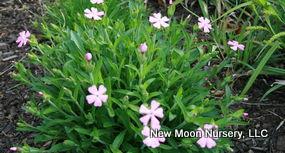Printed at http://www.newmoonnursery.com/index.cfm/
Silene caroliniana
Wild pink
Native to North America
FIRST IMPRESSIONS: Silene caroliniana is a tufted perennial wildflower with narrow lance-shaped leaves. In spring loose clusters of rosy pink flowers with dark centers rise above the foliage on slender stems. The floret bases are tubular and the petals are spreading and wedge shaped similar to phlox. Plants thrive in sunny or partially shaded gardens with well drained moist or dry soil.
HABITAT & HARDINESS: Silene caroliniana occurs in the eastern United States from New Hampshire to the Florida panhandle and west to Ohio, Kentucky, Missouri, Tennessee and Alabama.
This species is indigenous to dry rocky, gravelly or sandy deciduous woods, calcareous forests, open wooded clearings, barrens and rock outcrops.
Plants are hardy from USDA Zones 4-8.
PLANT DESCRIPTION: Silene caroliniana is a low mounding taprooted wildflower. New growth originates from a caudex or woody ground level stem.
Leaves are semi-evergreen and mostly basal. The lower leaves have petioles and are 1-4” long. The blades are narrowly oval but broadest toward the tip. The stem leaves are arranged in pairs and are sessile and smaller than the lower leaves. Leaves have rounded or bluntly pointed tips.
In spring clusters of bright pink flowers rise above the foliage. Florets have narrow tubes that spread into 5 wide notched petals. The calyx is covered with sticky glandular hairs.
After flowering, elongated capsules less than ½” long form. Each has an opening at the tip surrounded by 6-8 recurved teeth. The seed inside are dark brown and kidney shaped.
Flowering stems rise to 1’ and plants spread to 1’.
CULTURAL & MAINTENANCE NEEDS: Silene caroliniana flourishes in sun or part shade and extremely well drained soil.
Plants tolerate sandy, gravelly or rocky soil, drought, acid or alkaline pH and shallow infertile soil.
Plants are fairly pest resistant. They should be left undisturbed once established in the landscape.
LANDSCAPE USES: This Groundcover produces colorful spring carpets of flowers in Perennial Borders or Rock Gardens. It is an excellent native substitute for exotic Dianthus spp. in Containers or other garden situations. Plants are used as Butterfly Nectar Plants or as part of a Grouping or Mass Planting. Silene caroliniana has Showy Blooms and is appropriate for Cottage Gardens, Water-wise Landscapes and Low Maintenance Plantings.
COMPANION & UNDERSTUDY PLANTS: Try pairing Silene caroliniana with Amsonia hubrichtii, Baptisia tinctoria, Carex pensylvanica, Heuchera villosa, Monarda punctata, Sedum ternatum or Schizachyrium scoparium.
Phlox stolonifera is similar in appearance and could be substituted in partly shaded situations.
TRIVIA: Silene caroliniana provides nectar for native bees, butterflies, hummingbirds and nocturnal moths.
Silene caroliniana is sometimes called sticky catchfly because of the sticky hairs on the calyx that are reminiscent of fly paper. The sticky surface actually functions to deter ants from climbing to the flower to steal nectar.
This species belongs to the Pink Family (Caryophyllaceae). Family members have petals that are notched or fringed in some way. The stem leaves are opposite, sessile and attached in a way that makes the stem nodes look swollen. Silene spp. is the largest genus in the family.
Silene caroliniana is listed as an endangered species by the state of Florida.
Height:
1 ftSpread:
9-12 inSpacing:
12-18 inUSDA Hardiness Zone:
4-8Bloom Color:
PinkSilene caroliniana Characteristics
Attracts Wildlife
- Pollinators
- Butterflies
Attributes
- Rock Garden
- Naturalizing
- Ground Cover
- Drought Tolerant
Exposure
- Full Sun to Partial Shade
Flowering Months
- June
- May
Foliage Color
- Green
Growth Rate
- Medium
Season of Interest (Foliage)
- Spring
- Fall
- Summer
Soil Moisture Preference
- Well-Drained
- Dry to Moist
Interesting Notes:
For more information on this plant, visit the USDA PLANTS Database: http://plants.usda.gov/java/profile?symbol=SICA6

